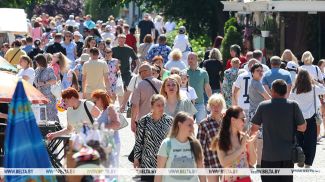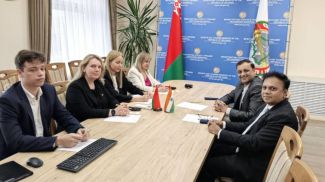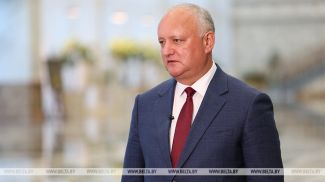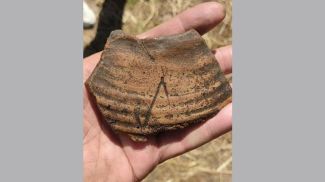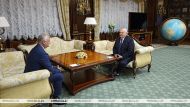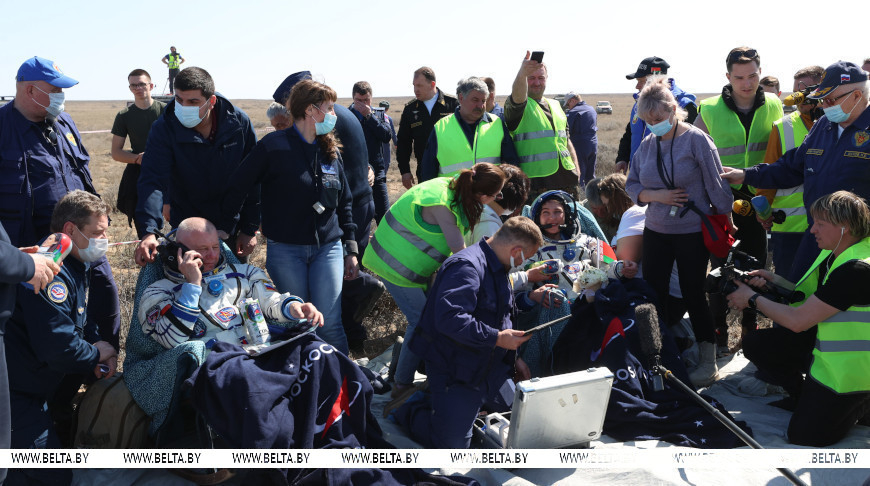
The flight to the International Space Station (ISS) was the most complicated mission not only for Belarus’ first cosmonaut Marina Vasilevskaya but for Belarusian reporters as well. In order to greet the crew of the Soyuz MS-24 spacecraft on the ground, they dared go to the plains of Kazakhstan despite the flood the country had not seen for 80 years, cold nights in the tent camp, and the possibility of the cosmonauts landing in a totally different place.
A team of reporters from the main Belarusian mass media shared the facts that had been left out of their work to cover events of special significance for our country.
Andrei Voropai: I didn’t even think it might happen that way
BelTA’s special reporter Andrei Voropai did not dream of becoming a cosmonaut even when he was a kid. But when he was told at the end of 2023 that he would go to Zvyozdny Gorodok on a business trip, he was overjoyed. Belarus’ two space flight candidates Marina Vasilevskaya and Anastasia Lenkova were training there.

“I was lucky to witness the historic moment of importance for our country,” Andrei said. Over the course of one year he has visited more than one training session of Belarus’ first woman cosmonaut.
He was one of the reporters, who went to the Baikonur Cosmodrome to see off Oleg Novitsky’s crew into the outer space.

Andrei recalled: “They were supposed to fly to the ISS on 21 March. On that day we arrived at the Cosmonaut Hotel, from where cosmonauts have been leaving [for the launch site] for many decades while accompanied by the song Trava u Doma [Grass outside home] by the music band Zemlyane [Earthlings]. There were plenty of tourists over there already. Approximately 1,200 according to Roscosmos calculations. The road was cordoned off for the crew’s passage. Strangers are not supposed to hug or shake hands with the cosmonauts. The cosmonauts were in a quarantine. Even their relatives couldn’t visit them. When the crew went outside the hotel, tourists rushed to meet them. Me and BelTA’s photo reporter Pavel Orlovsky were pressed against the turnstile but we kept working.”
All the Belarusian reporters mentioned they had had special conditions while working at the Baikonur Cosmodrome. There was no Internet access on the premises. Reporters had to seek unconventional solutions.
“Initially I would dictate a news article to a BelTA employee over the phone. The employee would show up for work at 6 in the morning specifically for that. It was a completely novel experience for me but older colleagues told me later on that it was the only way of doing it back in the 1990s because Internet access was almost non-existent,” the special reporter recalled.

With great difficulty he managed to find Wi-Fi access in a diner for cosmodrome personnel, this is why BelTA was the first news agency to pass information and photos of the crew getting ready for takeoff.
On the launch day Andrei was only 3km away from the launch pad. He was excited. The excitement peaked the moment he realized the rocket was supposed to be in the sky already but it was still on the ground.
“I didn’t even expect such a thing. When the loudspeaker announced that the launch had been cancelled, I felt empty. For many months I’d been working in anticipation of Soyuz MS-25’s takeoff. By inertia I went to the tent for mass media where colleagues were phoning their superiors and explaining what had happened. I heard tourists complaining about having paid money only to see no launch. I was disappointed but I mostly felt sorrow for Marina. At one point it even seemed to me that the launch would be totally canceled. I felt relief when a new date of the launch was announced,” BelTA’s special reporter recalled.


By the way, the crew sendoff ceremony was repeated on 23 March: the crew went outside the Cosmonaut Hotel with the song about Earth in the illuminator playing from the loudspeakers. However, the cosmonauts forgo to leave their signatures on the doors of the hotel for the second time.
“The thing is cosmonauts are exceedingly superstitious and try not to deviate from traditions,” Andrei explained.
The second attempt to launch the Soyuz crew transfer vehicle was a success. BelTA’s special reporter observed the takeoff from the same position he was at during the first attempt.

Andrei noted: “The huge rocket looked less than half of my palm from afar but when this massive thing took off, I realized why tourists pay a lot of money to see it. The flame billowing from under the rocket, the roaring noise I could distinctly hear even 3km away are hard to forget. I was overjoyed that the crew was flying into outer space after all and that Belarus had managed to rise so far into the sky!”

Pavel Orlovsky: We were running with plastic bags on our feet across the plain to the Soyuz
Before the very moment of the rocket’s takeoff BelTA’s photo reporter was closer than anyone else to Soyuz MS-25. And both times.
“The first time we arrived at the launch pad about 40 minutes before the crew did. The cosmonauts came to Soyuz on a bus. They needed assistance to walk to the rocket: the spacesuits are heavy and not very comfortable. The crew members waved at us, posed for photos, everyone was smiling. But I was worrying: these people had become nearly my family since they and I had spent a year together during the training process. We were waiting for the launch. I knew the timing of the launch to the second. I had prepared my cameras and suddenly realized that the time came and went but nothing happened. I looked into eyes of my colleagues and saw incomprehension as well. We stood far from the loudspeakers and didn’t know that the launch had been rescheduled. We were confident it was being delayed, this is why we stayed. We realized the rocket would not fly anywhere that day only when we saw buses and vehicles racing in our direction,” Pavel recalled.

He admitted he was worried about the crew on the backup launch date as well. But he rejoiced when the rocket went directly to the ISS! By the way, Pavel Orlovsky was not only the last man to see off Oleg Novitsky’s crew but also one of the first people to welcome him back.
“We flew by helicopter above the plain to the right location for two hours. There was no communication. We didn’t understand whether things were proceeding to plan or not. We were flying to where the module with the cosmonauts was supposed to land in a routine scenario. But we also knew that an emergency landing might put them in a totally different location. While in the air colleagues from Roscosmos started putting their legs into plastic bags and sealing them off with duct tape. They explained the plain had been severely flooded. We followed their example. But when we landed, it turned out that the ground was dry and the air was hot. But there was no time to take off the plastic bags. This is why we had to brave thorny bushes and run to the module with the cosmonauts while wearing the bags,” the photo reporter laughed.

He saw a huge parachute in the sky from the helicopter’s window when one of the colleagues shouted “Look!” and pointed at something distant. Everyone felt great relief at that moment.



“The helicopter flew closer to the landing module and started circling around it. During these several circles we took pictures of the landing site from several angles. It was certainly impressive to see such a huge pillar of sand in the air! By that time we had learned that pyrotechnic charges are fired to make landing softer. The helicopter landed about 300 meters from the cosmonauts. We ran to them nonstop in order to find out whether everything was all right. We managed to take pictures of the crew through an illuminator even before the hatch was opened. Oleg Novitsky was the first person I saw. He was sitting in the center, relaxed and smiling. This is how I realized that everything had been well,” Pavel Orlovsky recalled.


He admitted he had been worrying about Marina: it was her first flight and the training process had been completed on a tight schedule. He believes her actions are heroic and that the first Belarusian woman cosmonaut is a bold, sincere, and strong person.
Yegor Yermalitsky: I saw a marmot before the rocket’s launch as a good omen
Yegor Yermalitsky, a photo reporter with the publishing house Belarus Segodnya, realized before everyone else that the rocket with Marina Vasilevskaya on board would definitely take off on the backup launch date. His confidence was bolstered by… a marmot.

“My cameras were already ready to roll, the rocket was about to take off when I noticed a marmot getting out of a burrow. I guess, it also wanted to see the takeoff,” Yegor smiled. “I realized right away it is a good omen and this time the Soyuz will definitely deliver the cosmonauts to the ISS. Besides, in my camera’s viewfinder I could see that the launch process went further than it did the first time. By the way, when the launch was rescheduled, not only Belarusians were worried. Residents of [the town of] Baikonur were worried as well: it had never happened in their memory.”
The legendary Baikonur, where everyone who is at least a little bit interested in space exploration wants to go to, looked like an open-air museum to Yegor Yermalitsky. One can feel the time of Yuri Gagarin there.

“In intervals between launches I managed to take a walk around the town: I had had no time to spare before that,” the photo reporter noted. “Baikonur has some special vibe. This town is full of space exploration theme. There are plenty of sculptures focusing on space exploration. Space exploration is also reflected in murals on walls of standard Soviet-era five-story residential buildings that line up Gagarina Avenue. There is no doubt it is a very atmospheric place.”
Anastasia Benedisyuk: Some wept with joy when we saw a parachute in the sky
Anastasia Benedisyuk, a journalist with the Belarusian State Television and Radio Company, was one of the first people to reach Soyuz MS-24’s landing site soon after touchdown. Before that she had had to go a lengthy and complicated way. And it started with the news that Kazakhstan’s plains were experiencing extreme torrential rains the likes of which had not been seen for about 80 years.
“Three days before the Soyuz MS-24 crew arrived, we were told that specialists and military personnel, who will go to the landing site, will be fitted with rubber boots and boats. Flooding in Kazakhstan had already been record-high by then! Possible use of the amphibian vehicles Blue Bird was also mentioned. Such vehicles have been used during Soyuz landing and recovery operations for 30 years already. Thank god, we needed neither boats nor rubber boots: although vehicles with reporters were sometimes stuck in swamps and deep puddles, we crossed 500km to the field camp on the plains just fine. By the way, it was not the only site where Soyuz MS-24 could have landed. There was another one. Specialists hoped it would remain a backup site because water was already two meters deep over there,” Anastasia Benedisyuk said.

The reporters arrived at the field camp on Friday evening. It meant they would have to spend a cold night on the plains. But in the morning Anastasia realized it had been worth it. She looked up and saw a huge parachute carrying the landing module with the cosmonauts.

“It was such an exciting moment that some even wept with joy because the parachute had opened! We raced to the vehicles right away in order to go to the landing site. Wind started pushing the module to the side. As a result, we had to travel for 8km. We arrived slightly sooner than rescue workers and all the specialists. When Soyuz hatches were opened, the first thing I noticed was that Marina was as beautiful and kept smiling as she did during all our previous meetings. When I looked at her, I didn’t feel that the flight had taken its toll although it is heavy work and an unbelievable burden. But our first woman cosmonaut was smiling and was moved by the fact that so many people had turned up to greet the crew,” Anastasia Benedisyuk noted.

The reporters did not come empty-handed. Anastasia had brought a miniature bunch of chamomiles from the very city of Karaganda: there was no point in bringing a big one. The TV hostess Anna Kviloria had brought bacon and bread from Minsk. Deputy Head of the Aerospace Activities Department of the National Academy of Sciences of Belarus Ivan Bucha had brought apple juice according to Marina Vasilevskaya’s wishes and birch tree juice for Oleg Novitsky.



“Oleg Novitsky has a long tradition of drinking a bit of birch tree juice after landing,” the reporter explained. She mentioned she had felt great joy during the moment of meeting with the crew on the ground. “I felt pride for Marina Vasilevskaya, for the specialists, who had selected her from among all the candidates for the flight, for our entire country. Now Belarus is also represented in manned cosmonautics!”

Photos by BelTA and by the abovementioned reporters.




